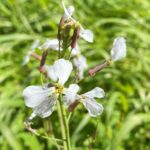Αρκορεπάνιν, Ράφανος ο ραφανοειδής
Etymology of Raphanus raphanistrum: The name of the genus derives from Ancient Greek "ράφανος" [rafanos], which was the ancient Greek name for the turnip, and it was later used for the radish too. Latinized "raphanistrum" derives from "raphanus" and the suffix "-trum" (a suffix forming instrument nouns), meaning "raphanus-like".
There is one Raphanus species/taxa growing in the Cypriot wild habitat.
Raphanus raphanistrum is a relatively common plant in Cyprus. It can be found in most Cyprus regions except for the Karpasia peninsula. It grows at an altitude of up to 250 metres only, primarily on cultivated fields and unfertile ground. Its flowering period is between February and March.
How to identify Raphanus raphanistrum:
Raphanus raphanistrum has slender fruits, 2-6 mm in diameter, markedly constricted between the seeds, and breaking readily into 1-seeded joints; its petals are white, lilac or yellow with a conspicuous dark venation; its taproot is slender.
Raphanus sativus has thick fruits, 5-20 mm in diameter, not distinctly constricted between the seeds, and not breaking into 1-seeded joints; its petals are usually purple or mauve, and not conspicuously veined; its taproot is fusiform or cylindrical and fleshy.
Raphanus raphanistrum is also extremely similar to Eruca vesicaria, the common "rocket".







